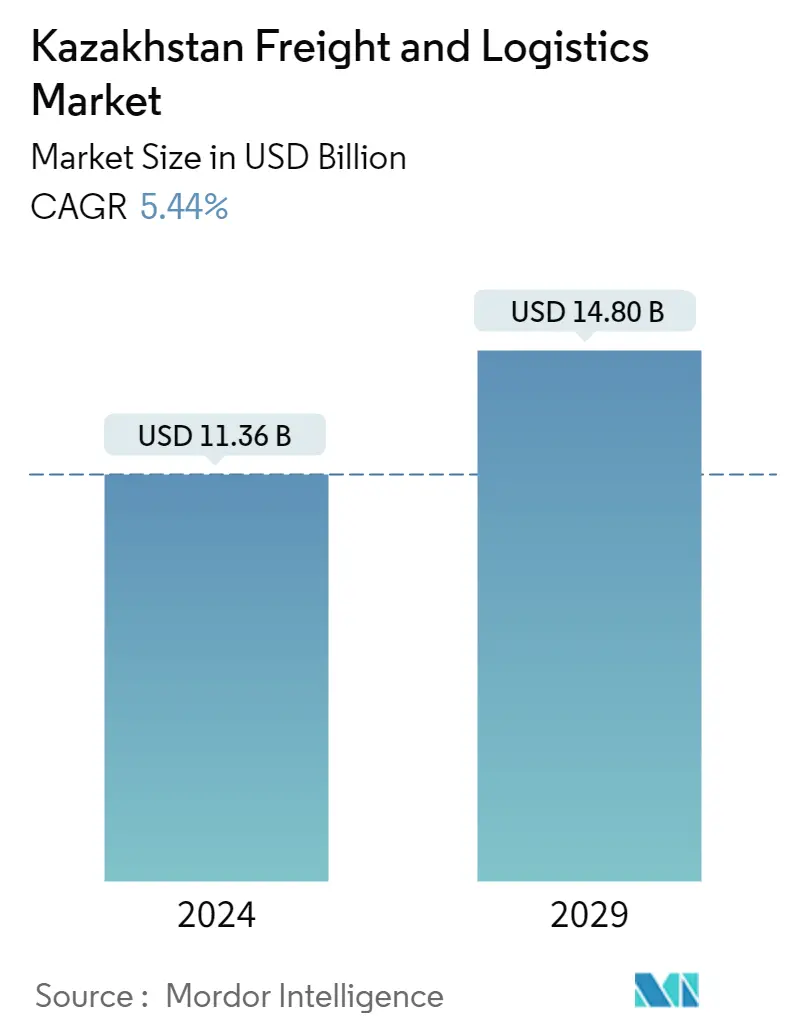Market Size of Kazakhstan Freight and Logistics Industry

| Study Period | 2020 - 2029 |
| Base Year For Estimation | 2023 |
| Market Size (2024) | USD 11.36 Billion |
| Market Size (2029) | USD 14.80 Billion |
| CAGR (2024 - 2029) | 5.44 % |
| Market Concentration | Low |
Major Players
*Disclaimer: Major Players sorted in no particular order |
Kazakhstan Logistics Market Analysis
The Kazakhstan Freight and Logistics Market size is estimated at USD 11.36 billion in 2024, and is expected to reach USD 14.80 billion by 2029, growing at a CAGR of 5.44% during the forecast period (2024-2029).
The market is driven by the shift of companies and routes from Russian territories to Kazakhstan's territories. Furthermore, the market is propelled by the growth in e-commerce and cross-border rail freight.
- The revenue generated by the logistics sector is almost evenly distributed across the country's regions. When we compare this distribution to the spread of retail trade and e-commerce values, we see significant gaps in the regional structure, with Almaty, Nursultan, and Atyrau dominating the market. In recent years, Kazakhstan's freight volume has increased. Freight transportation by all modes of transport (excluding pipelines) reached 4.2 billion tons in 2021, owing to increased e-commerce and better utilization of the country's transit potential. Total transportation revenue (excluding pipelines) reached KZT 1.4 trillion (USD 3.25 billion), with cargo transportation accounting for 78%.
- The consequences of military actions in Ukraine disrupted the entire region's logistics chains: sanctions imposed on Russia and Belarus, suspension of business operations in Russia by several large logistics operators, including Maersk, DSV, and DB Schenker, and the blocking of railway and sea communications - all of this resulted in the blocking of the first and second of the listed routes. Switching cargo shipments to new routes necessitates additional time and investment in increased transport capacity as well as additional CAPEX on vehicles. It has the potential to increase transportation and warehousing costs, burdening producers and importers and reflecting the shelf price of goods. However, price inflation is only one aspect of the issue.
- The demand for warehousing facilities will continue to rise in the short and medium term due to organic factors such as the expanding e-commerce market and the current market situation of companies' cash cycles lengthening. An additional factor supporting the attractiveness of the Kazakh logistics sector will be the anticipated relocation of some businesses from Russia to Kazakhstan. Some of these companies are expected to import non-sanctioned goods into Kazakhstan and then export them to Russia. Furthermore, the exit of large consumer companies from the Russian market opens the door for various intermediaries to purchase the same products in other markets and import them from third countries to meet the demand of Russian consumers.
- Modern geopolitical realities alter Eurasia's logistics map and cargo flow direction. Central Asian countries have already begun using Azerbaijan's transit potential to gain access to global markets. Azerbaijan is being chosen as a transit route by large cargo owners and logistics companies from the aforementioned countries. Freight from Kazakhstan is transported via two routes: the Caspian Sea and the Samur-Yalama border crossing. Rail freight transport between Azerbaijan and Kazakhstan totaled 950,000 tons (an increase of eight times) from January to October 2022, with transit traffic accounting for 96%, according to ADY Express LLC, a subsidiary of Azerbaijan Railways CJSC. These volumes are expected to grow further. Legal and diplomatic efforts are being made to establish a joint venture through the railway administrations of Azerbaijan, Georgia, and Kazakhstan.
Kazakhstan Logistics Industry Segmentation
Freight and logistics refer to the transportation of goods in the domestic and international markets via various modes, including air, rail, and roadways. A complete background analysis of the Kazakhstan freight and logistics market, including the assessment of the economy and contribution of sectors in the economy, market overview, market size estimation for key segments, and emerging trends in the market segments, market dynamics, and geographical trends, and COVID-19 impact is included in the report.
The Kazakhstan Freight and Logistics Market is segmented by Function (Freight Transport, Freight Forwarding, Warehousing, Value-added Services, Cold Chain Logistics, Last-mile Logistics, Return Logistics, and Other Emerging Areas) and End User (Construction, Oil and Gas and Quarrying, Agriculture, Fishing, and Forestry, Manufacturing and Automotive, Distributive Trade, Telecommunications, and Other End Users). The report offers market size and forecast values (USD billion) for all the above segments.
| By Function | |||||||
| |||||||
| Freight Forwarding | |||||||
| Warehousing | |||||||
| Value-added Services | |||||||
| Cold Chain Logistics, Last-mile Logistics, Return Logistics, and Other Emerging Areas |
| By End User | |
| Construction | |
| Oil and Gas and Quarrying | |
| Agriculture, Fishing, and Forestry | |
| Manufacturing and Automotive | |
| Distributive Trade | |
| Telecommunications | |
| Other End Users (Pharmaceutical and Healthcare) |
Kazakhstan Freight and Logistics Market Size Summary
The logistics industry in Kazakhstan is experiencing significant growth, driven by geopolitical shifts and the expansion of e-commerce. The market is evolving as companies and trade routes increasingly move from Russian territories to Kazakhstan, enhancing the country's role as a logistics hub. This transition is further supported by the growth in cross-border rail freight and the digital economy, with online retail sales gaining momentum. The demand for warehousing facilities is expected to rise due to the expanding e-commerce market and longer cash cycles for businesses. Additionally, the anticipated relocation of some companies from Russia to Kazakhstan is expected to bolster the logistics sector, as these companies import non-sanctioned goods and export them to Russia.
Kazakhstan's strategic geographical location positions it as a crucial transcontinental link between Europe and Asia, with rail transport playing a vital role in this connectivity. The country is enhancing its rail infrastructure to support increased trade with China and other Central Asian nations, which is expected to boost trade flows and improve connectivity. Despite challenges such as fragmented market structures and historical trade barriers, the logistics market is witnessing increased investment and participation from both local and international players. The presence of major logistics companies and collaborations, such as those with Kazakh State Railways, underscores Kazakhstan's growing importance as a logistics hub connecting Europe to Asia.
Kazakhstan Freight and Logistics Market Size - Table of Contents
-
1. MARKET INSIGHTS DYNAMICS
-
1.1 Current Market Scenario
-
1.2 Market Overview
-
1.3 Market Dynamics
-
1.3.1 Drivers
-
1.3.2 Restraints
-
1.3.3 Opportunities
-
-
1.4 Value Chain / Supply Chain Analysis
-
1.5 Porter's Five Forces Analysis
-
1.5.1 Threat of New Entrants
-
1.5.2 Bargaining Power of Buyers/Consumers
-
1.5.3 Bargaining Power of Suppliers
-
1.5.4 Threat of Substitute Products
-
1.5.5 Intensity of Competitive Rivalry
-
-
1.6 Government Regulations and Initiatives
-
1.7 Technological Trends (Overview of Industry 4.0 in Kazakhstan and its Impact on the Logistics Sector)
-
1.8 Insights into the E-commerce Industry (Domestic and Cross-border E-commerce)
-
1.9 Insights into Areas, such as Courier, Express, and Parcel (CEP) Industry, Contract Logistics (Including Market Sizes)
-
1.10 Brief on Freight Transportation Costs/Freight Rates in Kazakhstan
-
1.11 Trends in Intermodal Transportation in Kazakhstan
-
-
2. MARKET SEGMENTATION
-
2.1 By Function
-
2.1.1 Freight Transport
-
2.1.1.1 Road
-
2.1.1.2 Shipping and Inland Water
-
2.1.1.3 Air
-
2.1.1.4 Rail
-
2.1.1.5 Pipeline
-
-
2.1.2 Freight Forwarding
-
2.1.3 Warehousing
-
2.1.4 Value-added Services
-
2.1.5 Cold Chain Logistics, Last-mile Logistics, Return Logistics, and Other Emerging Areas
-
-
2.2 By End User
-
2.2.1 Construction
-
2.2.2 Oil and Gas and Quarrying
-
2.2.3 Agriculture, Fishing, and Forestry
-
2.2.4 Manufacturing and Automotive
-
2.2.5 Distributive Trade
-
2.2.6 Telecommunications
-
2.2.7 Other End Users (Pharmaceutical and Healthcare)
-
-
Kazakhstan Freight and Logistics Market Size FAQs
How big is the Kazakhstan Freight and Logistics Market?
The Kazakhstan Freight and Logistics Market size is expected to reach USD 11.36 billion in 2024 and grow at a CAGR of 5.44% to reach USD 14.80 billion by 2029.
What is the current Kazakhstan Freight and Logistics Market size?
In 2024, the Kazakhstan Freight and Logistics Market size is expected to reach USD 11.36 billion.

